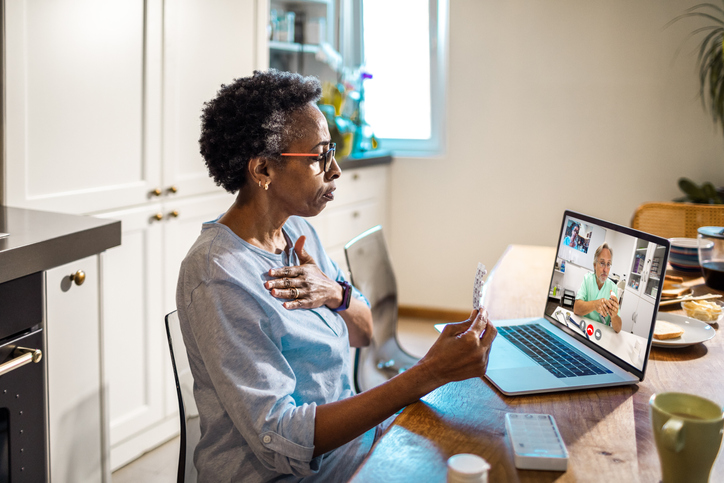 |
|
Opportunities for synchronous telehealth visits, wherein both parties connect in real time, are rather few. An approach that combines teleophthalmic visits with asynchronous testing might be more feasible for subspecialty-level evaluation. Photo: Getty Images. |
Telehealth in eye care has historically followed the “store-and-forward” model, wherein retinal photography is combined with remote interpretation for screening of ophthalmic diseases, such as diabetic retinopathy and retinopathy of prematurity, but is otherwise less useful than in some other medical fields. Did the pandemic experience change that in any way, positive or otherwise? A recent study published in JAMA Ophthalmology compared telehealth trends between different medical specialties and ophthalmic subspecialties at a major academic institution over 18 months, beginning at the onset of the COVID-19 pandemic. In April 2020, a hybrid model of care delivery was implemented wherein asynchronous data could be collected to enhance telehealth consultation with eyecare clinicians.
The hybrid model of augmented telehealth in the study increased the depth of remote evaluation across several subspecialties. On the other hand, its highest users were subspecialties that had lower telehealth adoption and are known to be less amenable to virtual practice (e.g., cornea and glaucoma). Asynchronous testing data from this program changed management in 25.4% of encounters and expanded telehealth use to new indications, including the postoperative assessment of corneal transplantation.1
The asynchronous data in the hybrid model included visual acuity, intraocular pressure measurement, pachymetry, visual field testing, OCT (macula or optic nerve), retinal photography, specular microscopy and slit lamp photography. The overall quality improvement study evaluated retrospective, longitudinal, observational data from the first 18 months of the COVID-19 pandemic (January 1, 2020, through July 31, 2021) for 881,080 patients receiving care from outpatient primary care, cardiology, neurology, gastroenterology, surgery, neurosurgery, urology, orthopedic surgery, otolaryngology, obstetrics/gynecology and ophthalmology.
The volume of in-person outpatient visits dropped by 83.3% (39,488 of 47,390) across the evaluated specialties at the onset of shelter-in-place orders for the COVID-19 pandemic, and the initial use of telehealth increased for these specialties before stabilizing over the 18-month study period. The highest use was found in gastroenterology, urology, neurosurgery and neurology, and the lowest use was in ophthalmology.
Asynchronous testing was combined with 126 teleophthalmology encounters, resulting in change of clinical management for 32 patients (25.4%) and no change for 91 (72.2%). In ophthalmology, telehealth use peaked at 31% encounters early in the pandemic and returned to mostly in-person visits as COVID-19 restrictions were lessened. After the stay-at-home orders were lifted, ophthalmic use of telemedicine (1.1%) returned almost entirely to pre-pandemic levels, while other specialties continued to provide a considerable percentage of visits remotely (14.9% to 65.9%).
Consistently, oculoplastics and pediatric ophthalmology, which often rely on external examination of the eye, had the greatest telehealth use during the COVID-19 shelter-in-place orders and, interestingly, maintained some level of telehealth even after the orders were lifted. However, these two specialities did not use the asynchronous model, which suggested a relative reliance on external video examination. In contrast, the retina, glaucoma and cornea subspecialties, which rely more heavily on microscopic examinations and specialized tools to evaluate ocular health and anatomy, did not employ telehealth services as often.
“Telehealth use by ophthalmology was modest compared with other specialties, and patient care returned almost entirely to in-person settings by October 2020,” the researchers noted in their paper.1
In-Person Care Still Preferable
A commentary also published in JAMA Ophthalmology emphasized that the most important reason for the lag in ophthalmology’s adoption of telehealth during the COVID-19 public health emergency perhaps lay in the visual nature of its practitioners' work. “Literally seeing the pathology is integral to our evaluation and management decisions to a greater degree than in most other specialties,” the author of the commentary wrote. “The techniques and devices used to facilitate visualization are not easily transferable to a remote visit.”2
Once clinicians developed protocols to reduce the risk of person-to-person spread, the author noted that hybrid systems gave way to the greater efficiency of same-day in-person testing and visits.2
“There are potential technological solutions to these limitations, offering the promise of access to care to remote and disadvantaged populations but only if the industry can realize a return on investment in developing new technology and healthcare professionals can use the resulting devices without incurring financial penalties,” the author wrote.2
The study concluded, “Additional work is needed to evaluate asynchronous testing in a subspecialty-controlled fashion and whether implementation outside the same institution may also be an effective approach for expanding the reach of ophthalmic telehealth care into the community.”1
1. Mosenia A, Li P, Seefeldt R, et al. Longitudinal use of telehealth during the COVID-19 pandemic and utility of asynchronous testing for subspecialty-level ophthalmic care. JAMA Ophthalmol. December 1, 2022. [Epub ahead of print]. 2. Glasser DB. Is there a future for telehealth in ophthalmology? JAMA Ophthalmol. December 1, 2022. [Epub ahead of print]. |


